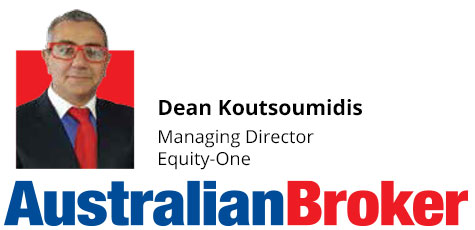Commercial Renaissance
- Original article featured in Australian Broker
- 4 October 2017
Dean Koutsoumidis, managing director of non-bank lender Equity-One, tackles the changes and challenges affecting commercial lending, and explains why brokers shouldn’t be afraid of having frank discussions with lenders.
View Original Article
Q: What are some trends in commercial lending?A: Specialising in the commercial space has always provided lenders with an opportunity to establish a niche in the market. Commercial lending today is no different, but it has been the subject of considerable attention. The most significant development is the gradual yet powerful impact of credit tightening by major lenders, which customers have endured since late 2015. Be it due to APRA-influenced constraints, cost of capital, or general bank appetite for this sector, the result for borrowers has been significant and palpable. Borrowers who have traditionally experienced strong and fruitful dealings with their banks are all of a sudden not able to engage with them. This does not appear to have had a material effect on the value or liquidity of commercial assets, but rather the flow of commercial enquiry has been redirected to non-bank lenders. They are in vogue, again.
Q: Do you expect restrictions similar to those placed on the residential sector to play out in the commercial space?
A: Despite all the chatter about this, I feel there are two types of people in this room: those who don’t know, and those who don’t know that they don’t know. The authorities have the ability to make sweeping changes in a variety of areas; however, some feel calm needs to be adopted. One of the key objectives of regulatory restrictions is to ensure the banks’ integrity and stability in the event of a financial shock. It is widely accepted that the prudential controls of the Australian banks are of the highest standard. The key focus is to ensure that this does not deteriorate. The need for these controls is also due to their dominance in market share. Smaller commercial lenders not only fall outside the banking system, they do not enjoy the same market share.
Q: Has there been an escalation in commercial property value, and if so, how has this affected the market?
A: Commercial property has, without a doubt, enjoyed considerable growth in recent years. Not only has this been spurred by SMSFs and overseas buyers looking for stable economies and good assets, but the sector has experienced something of a renaissance as buyers are desperate for yield in a low-yield, low-inflation world. Whilst growth in commercial property has been healthy, the real surge has been in development-related sites. Purchasers with appetites to buy sites valued in accordance with a projected end value have become prolific. Whilst buyers may be bullish in this area, it is for lenders to exercise caution. This, however, is not a unique or new risk. Valuing security with a moderate and considered approach should never go out of fashion irrespective of how heated a market becomes.
Q: What are some of the challenges you expect in commercial lending?
A: Like many businesses, lenders need to evolve and stay relevant to their customers. This is because new lenders are always entering the market. Fintechs have yet to largely impact the market, but it is a challenge that will no doubt influence current business models. Finally, the major banks will be ‘back in the game’ again. Their current pull-back should be viewed as a phase and not a permanent fixture.
Q: How does Equity-One take a prudent approach to lending?
A: We provide an alternative for creditworthy, strong borrowers who simply are not being accommodated by the banks right now. Whilst we are happy to fund commercial property acquisitions, refinance, or cash-out on residual stock to further fund commercial opportunities, we do not lend on the increased value derived from DAs or ‘end-value’ rationales. Any good development starts with a good asset purchase for a fair price. We value it as such, with the understanding that even if the proposed development does not proceed the underlying asset value will not be compromised as it should have intrinsic value.
Q: What questions should brokers be asking lenders?
A: It really is about their relevance in the marketplace. For example, our one-year fixed rate loans allow borrowers to repay after three months with no interest break fee/costs. This provides them with short-term solutions without paying typical ‘short-term prices’. Brokers are savvy and will quickly evaluate whether a lender is relevant and has a point of difference. Our strong suit is the ability to talk through and work with brokers to help them in whatever area they need. We are deliberately old-fashioned in that we value personal service. Brokers shouldn’t be deterred from having an active dialogue with lenders. If a lender’s products or service falls short, it is of high value if a broker feels comfortable enough to express that to them. After all, the lender wants to accommodate them where they can. Brokers may be surprised what a frank conversation can achieve.
Q: How do you think APRA’s increased oversight of non-banks will affect the sector?
A: If changes are measured, considered and done via an effective consultative dialogue with market players, then I think it will be just another evolvement of regulation in this industry. This may well be a welcome change. Like any changes, however, the fear is that regulators will throw the baby out with the bath water. Overreaching changes have the potential of damaging a sector which provides a legitimate alternative for commercial borrowers who enjoy respite from the major banks from time to time. The government insists it wants to broaden competition, so any unmeasured approach may have the opposite effect.

